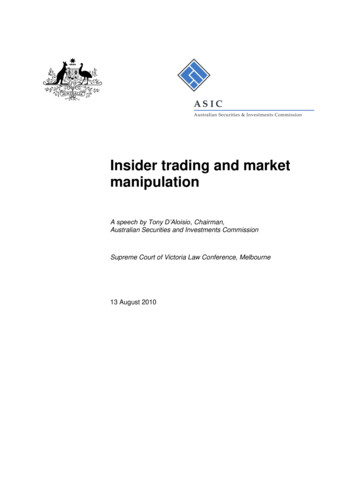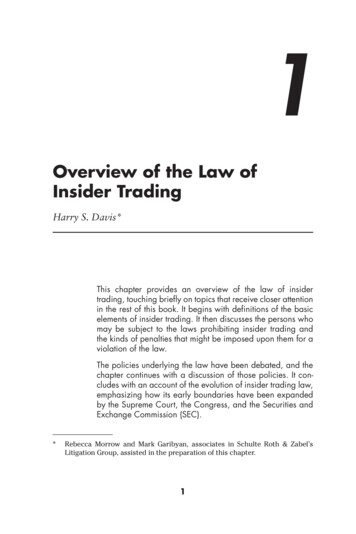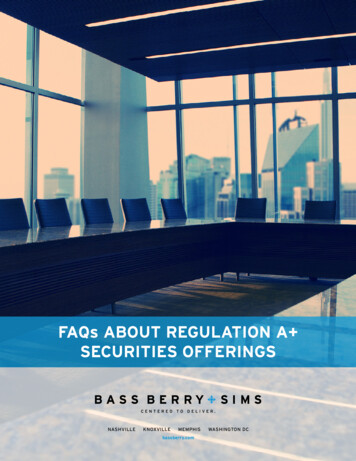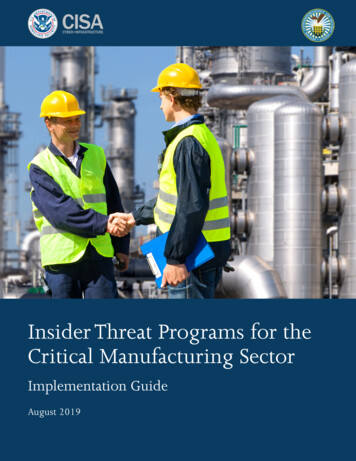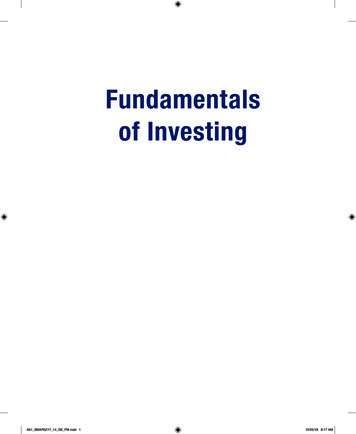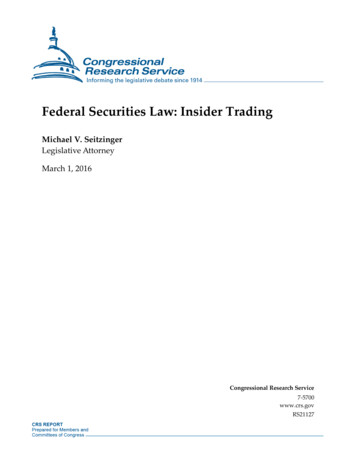
Transcription
Federal Securities Law: Insider TradingMichael V. SeitzingerLegislative AttorneyMarch 1, 2016Congressional Research Service7-5700www.crs.govRS21127
Federal Securities Law: Insider TradingSummaryInsider trading in securities may occur when a person in possession of material nonpublicinformation about a company trades in the company’s securities and makes a profit or avoids aloss. Certain federal statutes have provisions which have been used to prosecute insider tradingviolations. For example, Section 16 of the Securities Exchange Act of 1934 requires thedisgorgement of short-swing profits by named insiders—directors, officers, and 10%shareholders. The 1934 Act’s general antifraud provision, Section 10(b), is frequently used in theprosecution of insider traders. Although the statute does not specifically mention insider tradingbut, instead, forbids the use of “manipulative or deceptive” means in buying or selling securities,case law has made clear that insider trading is the type of fraud that is prohibited by Section10(b). Securities and Exchange Commission rules issued to implement Section 10(b), particularlyRule 10b-5, have also been frequently invoked in insider trading prosecutions. In the InsiderTrading Sanctions Act of 1984 and the Insider Trading and Securities Fraud Enforcement Act of1988, Congress enacted legislation imposing up to treble damages (and in some cases the greaterof 1 million or up to treble damages) on a person found guilty of insider trading. More recently,the Stop Trading on Congressional Knowledge (STOCK) Act of 2012 explicitly stated that thereis no exemption from the insider trading prohibitions for Members of Congress, congressionalemployees, or any federal officials. As stated above, SEC Rule 10b-5 is the most frequently usedSEC rule in lawsuits that charge violations of insider trading prohibitions. However, other SECrules, some of which specifically target insider trading, are also important. There are numerouscases that have used Section 10(b) and Rule 10b-5 to prosecute insider trading violations.The decision by the U.S. Court of Appeals for the Second Circuit (Second Circuit) in UnitedStates v. Newman has brought increased attention to the issue of insider trading. In its December10, 2014, decision, the Second Circuit overturned two high-profile convictions for insider trading.The court did not simply vacate the convictions; it remanded for the district court to “dismiss theindictment with prejudice,” thereby forbidding the government from refiling the case. The SecondCircuit held that the evidence against two stock fund analysts could not sustain a guilty verdictbecause the government did not adequately show that the alleged insiders received personalbenefits for providing information to the stock fund analysts and that the government did notpresent evidence that the defendants knew that they were trading on inside information obtainedfrom insiders who were violating their fiduciary duties. The U.S. Attorney for the SouthernDistrict of New York asked the Second Circuit to reconsider the ruling, but on April 3, 2015, theSecond Circuit denied the U.S. Attorney’s request. On July 30, 2015, the U.S. Department ofJustice asked the Supreme Court to review the Second Circuit decision. On October 5, 2015, theU.S. Supreme Court declined to hear the Newman insider trading appeal.On July 6, 2015, a case decided by the U.S. Court of Appeals for the Ninth Circuit may havefurther complicated insider trading law. The case, Salman v. United States, affirmed a lower courtdecision finding a breach of fiduciary duty and creation of a personal benefit in a family insidertrading situation, holding that the “gift” of inside information was sufficient to create liability forinsider trading. On January 19, 2016, the U.S. Supreme Court granted certiorari in the Salmancase.Several bills, including H.R. 1173, H.R. 1625, and S. 702, have been introduced in the 114thCongress to attempt to prevent the type of securities trading allowed by the Newman decision.This report will be updated as warranted.Congressional Research Service
Federal Securities Law: Insider TradingContentsOverview of Federal Statutes Related to Insider Trading. 1Securities Exchange Act of 1934 . 1Insider Trading Sanctions Act of 1984 . 2Insider Trading and Securities Fraud Enforcement Act of 1988 . 2Stop Trading on Congressional Knowledge (STOCK) Act of 2012 . 3Examples of Penalties for Insider Trading . 3Selected Regulations . 3Selected Decisions That Have Used Section 10(b) and Rule 10b-5 to Prosecute InsiderTrading Violations . 4United States v. Newman . 8United States v. Salman .11Congressional Interest in the Newman Decision . 13ContactsAuthor Contact Information . 14Congressional Research Service
Federal Securities Law: Insider TradingOverview of Federal Statutes Related toInsider TradingInsider trading in securities may occur when a person in possession of material nonpublicinformation about a company trades in the company’s securities and makes a profit or avoids aloss. Federal statutes have provisions which either specifically forbid insider trading or have beeninterpreted by courts to prohibit insider trading.Securities Exchange Act of 1934One provision in the Securities Exchange Act of 19341 is specifically designed to discourageinsiders in the corporation from taking advantage of their inside information in the trading of thecorporation’s securities. Section 16 of the 1934 Act2 places sanctions on insiders who use insideinformation in making short-swing profits. For purposes of this provision, an insider is defined asany “person who is directly or indirectly the beneficial owner of more than 10 percent of anyclass of any equity security . which is registered . or who is a director or an officer of theissuer.” Every person meeting the insider definition must file a report with the Securities andExchange Commission (SEC) at the time of the registration of the security on a national securitiesexchange or by the effective date of a filed registration statement or within 10 days after hebecomes a beneficial owner, director, or officer. If there has been a change in the ownership of thesecurity or if there has been a purchase or sale of a security-based swap agreement involving theequity security, the insider must file the report before the end of the second business dayfollowing the day on which the transaction has been executed.3To prevent the unfair use of inside information, Section 16(b) permits the company or anysecurity holder suing on behalf of the company to recover any profit which the person realizesfrom any purchase and sale or sale and purchase of any equity security of the company within aperiod of less than six months.Section 10(b)4 of the 1934 Act and SEC Rule 10b-55 are used in most cases of insider tradingviolations, as well as in other kinds of alleged securities fraud. Section 10(b) is the 1934 Act’sgeneral antifraud provision. Although it does not refer to specific types of fraud or to specifictypes of insiders, one of its most frequent applications over the years has been to insider trading.The statute states,It shall be unlawful for any person, directly or indirectly by the use of any means orinstrumentality of interstate commerce or of the mails, or of any facility of any nationalsecurities exchange:(a).(b) To use or employ, in connection with the purchase or sale of any security registeredon a national securities exchange or any security not so registered, or any securities-basedswap agreement any manipulative or deceptive device or contrivance in contravention of115 U.S.C. §§78a et seq.15 U.S.C. §78p.315 U.S.C. §78p(a).415 U.S.C. §78j(b).517 C.F.R.§240.10b-5.2Congressional Research Service1
Federal Securities Law: Insider Tradingsuch rules and regulations as the Commission may prescribe as necessary or appropriatein the public interest or for the protection of investors.(c).Rule 10b-5, mentioned later along with other SEC regulations which focus more specifically oninsider trading, is the general SEC rule which is used in all kinds of securities fraud cases. Therule states,It shall be unlawful for any person, directly or indirectly, by the use of any means orinstrumentality of interstate commerce, or of the mails or of any facility of any nationalsecurities exchange,(a) To employ any device, scheme, or artifice to defraud,(b) To make any untrue statement of a material fact or to omit to state a material factnecessary in order to make the statements made, in the light of the circumstances underwhich they were made, not misleading, or(c) To engage in any act, practice, or course of business which operates or would operateas a fraud or deceit upon any person,in connection with the purchase or sale of any security.Insider Trading Sanctions Act of 1984The Insider Trading Sanctions Act of 19846 was enacted because of the belief that[i]nsider trading threatens . markets by undermining the public’s expectations of honestand fair securities markets where all participants play by the same rules. This legislationprovides increased sanctions against insider trading in order to increase deterrence ofviolations.“Insider trading” is the term used to refer to trading in the securities markets while inpossession of “material” information (generally, information that would be important toan investor in making a decision to buy or sell a security) that is not available to thegeneral public.7The act provides that, if the commission believes that any person has bought or sold a securitywhile in possession of material nonpublic information, the commission may bring an action inU.S. district court to seek a civil penalty. The penalty may be up to three times the profit gainedor loss avoided.8Insider Trading and Securities Fraud Enforcement Act of 1988After a number of hearings and considerable debate in the 100th Congress, the President signedthe Insider Trading and Securities Fraud Enforcement Act of 1988.9 This act expanded the scopeof civil penalties to control persons who fail to take adequate steps to prevent insider trading.106P.L. 98-376, codified in a number of provisions of 15 U.S.C. §§78a et seq.H.Rept. 98-355, at 2 (1984).815 U.S.C. §78u-1(a)(2).9P.L. 100-704, codified in a number of provisions of the federal securities laws.1015 U.S.C. §78u-1(a)(3) imposed on a person controlling the violator a penalty of the greater of 1,000,000 or threetimes the profit gained or loss avoided. Limitations on the liability of controlling persons may be found at 15 U.S.C.§78u-1(b).7Congressional Research Service2
Federal Securities Law: Insider TradingThe act, among other things, also established a private right of action for buyers or sellers ofsecurities against the inside trader if they traded contemporaneously with the insider.11Stop Trading on Congressional Knowledge (STOCK) Act of 2012The STOCK Act,12 signed into law on April 4, 2012, makes clear that insider trading prohibitionsapply to Members of Congress, congressional staff, and other federal officials. According toSection 3 of the STOCK Act,[A] Member of Congress and an employee of Congress may not use nonpublicinformation derived from such person’s position as a Member of Congress or employeeof Congress or gained from the performance of such person’s official responsibilities as ameans for making a private profit.Section 9 of the STOCK Act places this prohibition on other federal officials and also affirms thenon-exemption from insider trading prohibitions for these officials:Executive branch employees, judicial officers, and judicial employees are not exemptfrom the insider trading prohibitions arising under the securities laws, including section10(b) of the Securities Exchange Act of 1934 and Rule 10b-5 thereunder.The STOCK Act also has provisions concerning financial disclosure reporting requirements forlegislative and executive branch officials.13Examples of Penalties for Insider TradingThere are both civil and criminal penalties14 for insider trading, and the penalties can varydepending on what statutes a trader is found guilty of violating. For example, 15 U.S.C. Section78u-1 sets out the civil penalties for securities transactions while in possession of materialnonpublic information. As mentioned above, the penalty can be up to three times the profit gainedor loss avoided. However, willful violations of other provisions, such as Section 10(b), thegeneral antifraud securities statute, may result in other significant penalties. These penalties foreach willful violation of a securities statute by an individual include fines up to 5 million and/orimprisonment up to 20 years; a business may be fined up to 25 million.15Selected RegulationsAs stated above, SEC Rule 10b-5, which implements Section 10(b) of the Securities ExchangeAct, is the most frequently used SEC rule in lawsuits that charge violations of insider tradingprohibitions. However, other SEC rules, some of which specifically target insider trading, are alsoimportant.Rule 10b5-116 prohibits trading “on the basis of” material nonpublic information. This rule statesthat one of the proscribed activities under Section 10(b) and Rule 10b-5 is securities trading “on1115 U.S.C. §78t-1.P.L. 112-105, codified in provisions and notes of several titles of the U.S. Code, particularly in Titles 5 and 15.13For more information on the STOCK Act, see CRS Report R42495, The STOCK Act, Insider Trading, and PublicFinancial Reporting by Federal Officials, by Jack Maskell.14The SEC typically seeks the civil penalties, and the Department of Justice typically seeks the criminal penalties.1515 U.S. C. §78ff.1617 C.F.R. §240.10b5-1.12Congressional Research Service3
Federal Securities Law: Insider Tradingthe basis of material nonpublic information about that security or issuer, in breach of a duty oftrust or confidence that is owed” to the issuer of the security, shareholders of the issuer, or anotherwho is the source of the inside information. The regulation defines “on the basis of” as having akind of knowledge requirement:[A] purchase or sale of a security of an issuer is “on the basis of” material nonpublicinformation about that security or issuer if the person making the purchase or sale wasaware of the material nonpublic information when the person made the purchase or sale.Various affirmative defenses are allowed to avoid prosecution under the rule, such as the allegedviolator’s demonstrating that, before becoming aware of the material nonpublic information, hehad entered into a binding contract to buy or sell the security, had instructed another person tobuy or sell the security for his account, or had adopted a written plan for trading securities.Rule 10b5-217 sets out duties of trust or confidence in misappropriation insider trading cases. Themisappropriation theory of insider trading is a fairly recent development in securities law. Underthe classical theory of insider trading, a corporate insider is prohibited from trading thatcorporation’s securities if the trade is based on inside information and if the trader has a duty oftrust and confidence to the corporation’s shareholders. In contrast to classical insider trading, themisappropriation theory finds liable a person not actually a corporate insider but who has insteadbeen provided inside information in confidence and who breaches a fiduciary duty to the sourceof the information in order to gain profit or avoid loss in the securities market. Rule 10b5-2 setsout examples of what is meant by “duties of trust or confidence.” They include a person’sagreement to maintain the disclosed information in confidence; a person’s history with thediscloser of the inside information indicating an expectation that the recipient of the informationwill keep the information in confidence; and a person’s receiving information from a spouse orclose relative, unless the recipient can show that he neither knew nor should have reasonablyknown or agreed that he would keep the information confidential.Regulation FD18 is another SEC rule which may concern a prohibition on insider trading.Regulation FD addresses selective disclosure. It provides that, when an issuer or any personacting on behalf of the issuer discloses material nonpublic information to certain enumeratedpersons (typically securities market professionals and holders of the securities), it must disclosethat information to the public. The disclosure of the material nonpublic information to the publicmust be made simultaneously with the intentional disclosure to the enumerated persons or aspromptly as possible to the public in the case of a non-intentional disclosure to the enumeratedpersons.Selected Decisions That Have Used Section 10(b)and Rule 10b-5 to Prosecute Insider TradingViolationsThere are numerous cases that have used Section 10(b) and Rule 10b-5 to prosecute insidertrading violations. What follows is a brief discussion of a few of the most important of thesecases.171817 C.F.R. §240.10b5-2.17 C.F.R. §243.100–243.103.Congressional Research Service4
Federal Securities Law: Insider TradingAlthough it was decided 25 years before the enactment of the Securities Exchange Act, Strong v.Repide19 illustrates that the common law rule of fiduciary duty, which is arguably the idea drivingthe case law imposing penalties for insider trading, prohibits a company insider from profitingfrom knowledge that he alone knows about the company. The Court stated,A director upon whose action the value of the shares depends cannot avail of hisknowledge of what his own action will be to acquire shares from those whom heintentionally keeps in ignorance of his expected action and the resulting value of theshares.This is a rule of common law.Even though a director may not be under the obligation of a fiduciary nature to disclose to ashareholder his knowledge affecting the value of the shares, that duty may exist in special cases,and did exist upon the facts in this case.In an administrative broker-dealer disciplinary proceeding, In re Cady Roberts & Co.,20 the SECheld that Section 10(b) and Rule 10b-5 prohibited insider trading by a person, in this case abroker-dealer, who may not actually be within the corporation whose stock has been traded butwho has received privileged information about the corporation from someone within thecorporation.The case concerned a partner in a brokerage firm who, after receiving a message from a directorof Curtiss-Wright that the board of directors had voted to cut the dividend, placed orders to sellsome of the stock before news of the dividend cut was disseminated to the public. The broker wasnot a corporate insider (i.e., he was not an officer, director, or significant shareholder). However,the SEC found that the broker’s conduct violated at least clause (3) of the above-quoted SEC Rule10b-5 in that it operated as a fraud or deceit on the purchasers and that there was no need todecide the scope of clauses (1) and (2). In determining that there was a violation of clause (3), theSEC appears to have found fraud committed on both the company and on persons on the otherside of the market:Analytically, the obligation [not to trade on inside information] rests on two principalelements: first, the existence of a relationship giving access, directly or indirectly, toinformation intended to be available only for a corporate purpose and not for the personalbenefit of anyone, and second, the inherent unfairness involved where a party takesadvantage of such information knowing it is unavailable to those with whom he isdealing. In considering these elements under the broad language of the anti-fraudprovisions we are not to be circumscribed by fine distinctions and rigid classifications.Thus, it is our task here to identify those persons who are in a special relationship with acompany and privy to its internal affairs, and thereby suffer correlative duties in tradingin its securities. Intimacy demands restraint lest the uninformed be exploited.The SEC rejected the broker’s argument that the obligation to disclose material information existsonly in a situation involving face-to-face dealings:It would be anomalous indeed if the protection afforded by the anti-fraud provisions werewithdrawn from transactions effected on exchanges, primary markets for securitiestransactions. If purchasers on an exchange had available material information known by aselling insider, we may assume that their investment judgment would be affected andtheir decision whether to buy might accordingly be modified. Consequently, any sales bythe insider must await disclosure of the information.1920213 U.S. 419 (1909).40 SEC 907 (1961).Congressional Research Service5
Federal Securities Law: Insider TradingThus, it appears that this case established that Section 10(b) and Rule 10b-5 extend beyondofficers, directors, and major stockholders to others who receive information from a corporatesource.Securities and Exchange Commission v. Texas Gulf Sulphur,21 a 1968 decision by the U.S. Courtof Appeals for the Second Circuit (Second Circuit), supported the SEC’s ruling in Cady Robertsby suggesting that anyone in possession of inside information must either publicly disclose theinformation or not trade the particular stock until the information becomes public.The U.S. Supreme Court appears, however, in 1980 to have somewhat modified Texas GulfSulphur by indicating that, for there to be a fraud actionable under Rule 10b-5, there must be aduty to disclose arising from a relationship of trust and confidence between parties to thetransaction. Chiarella v. United States22 alleged a violation of Rule 10b-5 by an employee of afinancial printer. The employee, who was involved in printing materials related to corporatetakeover bids, deduced the names of the target companies from information contained indocuments delivered to the printer by the acquiring companies. Without disclosing hisknowledge, the employee purchased stock in the target companies and sold the sharesimmediately after the information was made public, realizing a profit of 30,000. The lowercourts found a violation of Rule 10b-5 and convicted the employee of the print company forwillfully failing to inform the sellers of the target company securities that he knew of animminent takeover bid that would increase the value of their stock.The Supreme Court reversed. According to the Court, the employee in this situation did not havea duty to disclose the information. He was not a corporate insider and he received no confidentialinformation. In addition, no duty arose from the relationship between the printing companyemployee and the sellers of the target companies’ securities. The Court held that a duty to discloseunder Section 10(b) and Rule 10b-5 does not arise from the mere possession of nonpublic marketinformation.23Dirks v. Securities and Exchange Commission24 went perhaps a little further than Chiarella in thedirection of indicating that noncorporate persons with inside information are not always liablewhen trading on inside information. This case involved an officer of a broker-dealer whospecialized in providing investment analysis of insurance company securities to institutionalinvestors. He received information that the assets of an insurance company were greatly21401 F.2d 833 (2d Cir. 1968), cert. denied, 394 U.S. 976 (1969).445 U.S. 222 (1980).23Concurring and dissenting opinions in Chiarella suggest that, if the misappropriation theory of securities fraud hadbeen presented, Chiarella, a financial printer employee who deduced information from the printing materials related totakeover bids and then traded based on the information, might have been found guilty under it. Chief Justice Burgerbelieved that the employee’s conviction should have been affirmed because the “evidence shows beyond all doubt thatChiarella, working literally in the shadows of the warning signs [stating employer’s confidentiality policy] in theprintshop misappropriated—stole, to put it bluntly—nonpublic information entrusted to him in the utmost confidence.”Chiarella, 445 U.S. at 245 (Burger, C.J., dissenting). Although Justice Brennan disagreed with the Chief Justice’s viewof the evidence, he agreed that a “person violates section 10(b) whenever he improperly obtains or converts to his ownbenefit nonpublic information which he then uses in connection with the purchase or sale of securities.” Id. at 239(Brennan, J., concurring). Justice Blackmun, with whom Justice Marshall joined, wrote that, even without restingChiarella’s conviction on a misappropriation theory, he should have been convicted because he had “purloined”information (Blackmun, J., dissenting, id. at 246-252). Justice Stevens, who concurred in the opinion of the Court,wrote separately, emphasizing the “fact that we have not necessarily placed any stamp of approval on what thispetitioner did, nor have we held that similar actions must be considered lawful in the future.” (Stevens, J., concurring,id. at 238).24463 U.S. 646 (1983).22Congressional Research Service6
Federal Securities Law: Insider Tradingoverstated because of fraudulent corporate practices and that regulatory agencies had not acted onthese charges made by company employees. Although the officer of the broker-dealer did nothimself trade the stock, some of his customers did, based on information that they received fromhim. The price of the stock fell, and the SEC began investigations, eventually finding that theofficer had violated Rule 10b-5 by repeating the allegations of fraud to investors who later soldtheir stock in the insurance company. However, because of his role in uncovering the fraud, hereceived only a censure from the SEC.The Supreme Court found that no violation of Section 10(b) had occurred. In order to find aviolation of Section 10(b) by a corporate insider, two elements are necessary, according to theCourt: the existence of a relationship affording access to inside information intended to beavailable only for a corporate purpose and the unfairness of allowing a corporate insider to takeadvantage of that information by trading without disclosure. However, the duty arises from afiduciary relationship; in addition, there must be manipulation or deception to bring about abreach of the fiduciary duty. Here, according to the Court, the insider did not trade on the insideinformation, nor did he make secret profits. For the officer of the broker-dealer to have the dutyto disclose inside information or to abstain from trading, the officer must have breached hisfiduciary duty. Since he had no duty to abstain from using inside information, he had no preexisting fiduciary duty to the insurance company’s shareholders and, therefore, did not violateSection 10(b) or rule 10b-5.Seven years after Dirks, the Supreme Court decided another landmark securities case, Carpenterv. United States.25 Although the case did not find the defendants guilty under the misappropriationtheory of securities fraud, it did discuss the issue. In the Carpenter case, R. Foster Winans, aformer writer for the Wall Street Journal’s “Heard on the Street” column, and others were chargedwith violations of Section 10(b) and Rule 10b-5. They were also charged with violating thefederal mail and wire fraud statutes26 and with conspiracy.27 In researching information to be usedin his column, Winans interviewed corporate executives, but none of the information that heobtained contained corporate inside information. Because of its perceived quality and integrity,the column had the potential for affecting the prices of the stocks that it discussed.The Wall Street Journal’s official policy was that, before publication, the contents of the columnwere its confidential information. Despite being familiar with the rule, Winans agreed to givePeter Brant and Kenneth Felis, both employees of Kidder Peabody, advance information aboutthe columns. Brant, Felis, and another conspirator, David Clark, bought and sold stocks based onthe probable impact of the information that would later appear in Winans’s columns. The profitsfrom these trades over a four-month period amounted to 690,000. Kidder Peabody’s compliancedepartment eventually noticed correlations between the Winans columns and the Clark and Felisaccounts. The SEC began an investigation; Winans and his roommate, David Carpenter, revealedthe scheme; and the indictments followed.The lower courts found that Winans had knowingly breached a duty of confidentiality bymisappropriating prepublication information. They found that this misappropriation had violatedSection 10(b) and Rule 10b-5 because the deliberate breach by Winans of his duty ofconfidentiality was a fraud and deceit on the newspaper. The lower courts also held that Winanshad fraudulently misappropriated property within the meaning of the mail and wire fraud statutes.The p
trading situation, holding that the "gift" of inside information was sufficient to create liability for insider trading. On January 19, 2016, the U.S. Supreme Court granted certiorari in the Salman case. Several bills, including H.R. 1173, H.R. 1625, and S. 702, have been introduced in the 114th
